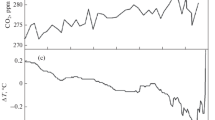Abstract
The paper considers the probable influence of variations of the global temperature and carbon dioxide concentration in the Earth’s atmosphere on the results of reconstruction of the production rate of the cosmogenic isotope 14C in the terrestrial atmosphere for the period from the early 15th to the mid 19th century. This time interval covers the Spörer, Maunder, and Dalton minima of solar activity, as well as the Little Ice Age. It was shown that the climate changes that occurred during the Little Ice Age should be taken into account. In the Maunder and Spörer minima of solar activity, the 14C generation rate may be comparable to the values for the Dalton minimum, while exclusion of the climate effect yields extremely large values of the 14C production rate for these grand minima. In the solar activity reconstruction for past epochs, this circumstance should be taken into consideration via measurements of the 14C concentration on a long time scale.
Similar content being viewed by others
References
Byutner, E.K., Planetarnyi gazoobmen O 2 i SO 2 (Planetary Gas Exchange of O2 and CO2), Leningrad: Gidrometeoizdat, 1986.
Crowley, T.J. and Lowery, T.S., How warm was medieval warm period?, Ambio, 2000, vol. 29, pp. 51–54.
Dergachev, V.A. and Ostryakov, V.M., The effect of temperature changes on the level of radiocarbon in the Earth’s atmosphere, in Trudy 6 vsesoyuznogo soveshchaniya po probleme “Astrofizicheskie yavleniya i radiouglerod”, Tbilisi 13–15 oktyabrya 1976 g. (Proc. of the 6th AllUnion Meeting on the Problem “Astrophysical Phenomena and Radiocarbon”, October 13–15, 1976), Tbilisi, 1978, pp. 177–182.
Dergachev, V.A. and Veksler, V.S., Primenenie radiouglerodnogo metoda dlya izucheniya prirodnoi sredy v proshlom (The Use of the Radiocarbon Method for Studying the Natural Environment in the Past), Leningrad: FTI, 1991.
Dorman, L.I., Peculiarities of the study of variations in cosmic rays by the radiocarbon method, in Trudy 6 vsesoyuznogo soveshchaniya po probleme “Astrofizicheskie yavleniya i radiouglerod”. Tbilisi 13–15 oktyabrya 1978 g. (Proc. of the 6th All-Union Meeting on the Problem “Astrophysical Phenomena and Radiocarbon”, October 13–15, 1976), Tbilisi, 1978, pp. 49–96.
Etheridge, D.M., Steele, L.P., Langenfelds, R.L., Francey, R.J., Barnola, J-M.I., and Morgan, V.I., Historical CO2 record derived from a spline fit (75-year cutoff) of the Law Dome DSS, DE08, and DE08-2 ice cores. http://cdiac.ornl.gov/ftp/trends/co2/lawdome.smoothed.yr75.
Hoyt, D.V. and Schatten, K.H., Group sunspot numbers: A new solar activity reconstruction, Sol. Phys., 1998, vol. 179, pp. 491–512.
International sunspot numbers: Royal observatory of Belgium, 2015. http://www.sidc.oma.be/html/sunspot.html.
Kocharov, G.E., Vasil’ev, V.A., Dergachev, V.A., and Ostryakov, V.M., Intensity of cosmic rays over the past ~8000 years, Pis’ma Astron. Zh., 1983, vol. 9, no. 4, pp. 206–210.
Kudryavtsev, I.V., Dergachev, V.A., Nagovitsyn, Yu.A., Ogurtsov, M.G., and Jungner, H., Influence of climatic factors on the past atmospheric content of the 14C isotope, Geomagn. Aeron. (Engl. Transl.), 2013, vol. 53, no. 8, pp. 927–931.
Koudriavtsev, Igor, Dergachev, Valentin, Nagovitsyn, Yury, Ogurtsov, Maxim, and Jungner, Högne, On the influence of climatic factors on the ratio between the cosmogenic isotope 14C and total carbon in the atmosphere in the past, Geochronometria, 2014, vol. 41, no. 3, pp. 216–222.
Malinin, V.N. and Obraztsova, A.A., Variability of Carbon Dioxide Exchange in the ocean–atmosphere system, Obshchestvo. Sreda. Razvitie, 2011, no. 4, pp. 220–226.
Mann, M.E., Bradley, R.S., and Hughes, M.K., Northern hemisphere temperatures during the past millennium: Inferences, uncertainties and limitations, Geophys. Res. Lett., 1999, vol. 26, pp. 759–762.
Moberg, A., Sonechkin, D.M., Holmgren, K., Datsenko, N.M., and Karlen, W., Highly variable northern hemisphere temperatures reconstructed from lowand high-resolution proxy data, Nature, 2005, vol. 433, pp. 613–617.
Nagovitsyn, Yu.A., A nonlinear mathematical model for the solar cyclicity and prospects for reconstructing the solar activity in the past, Astron. Lett., 1997, vol. 23, pp. 742–748.
Reimer, P.J., Baillie, M.G.L., Bard, E., Bayliss, A., Beck, J.W., Blackwell, P.G., Ramsey, C.B., Buck, C.E., Burr, G.S., Edwards, R.L., et al., IntCal09 and Marine09 radiocarbon age calibration curves, 0–50000 years cal BP, Radiocarbon, 2009, vol. 51, pp. 1111–1150.
Roth, R. and Joos, F., A reconstruction of radiocarbon production and total solar irradiance from the Holocene 14C and CO2 records: Implications of data and model uncertainties, Clim. Past, 2013, vol. 9, pp. 1879–1909.
Shevenell, A.E., Ingalls, A.E., Domack, E.W., and Kelly, C., Holocene Southern Ocean surface temperature variability west of the Antarctic Peninsula, Nature, 2011, vol. 470, pp. 250–254.
Takahashi, T., Olafson, J., Goddard, J.G., Chipman, D.W., and Sutherland, S.C., Seasonal variation of CO2 and nutrients in the high-latitude surface oceans: A comparative study, Global Biogeochem. Cycles, 1993, vol. 7, no. 4, pp. 843–878. doi 10.1029/93GB02263
Takahashi, T., Sutherland, S.C., Wanninkhof, R., et al., 2009. Climatological mean and decadal change in surface ocean pCO2, and net sea-air CO2 flux over the global oceans, Deep-Sea Res. II: Top. Stud. Oceanogr., vol. 56, pp. 554–577. doi 10.1016/j.dsr2.2008.12.009.
Usoskin, I.G., Hulot, G., Gallet, Y., Roth, R., Licht, A., Joos, F., Kovaltsov, G.A., Thébault, E., and Khokhlov, A., Evidence for distinct modes of solar activity, Astron. Astrophys., 2014, vol. 562, p. L10.
Zolotova, N.V. and Ponyavin, D.I., The Maunder Minimum is not as grand as it seemed to be, Astrophys. J., 2015, vol. 800, no. 1.
Author information
Authors and Affiliations
Corresponding author
Rights and permissions
About this article
Cite this article
Kuleshova, A.I., Dergachev, V.A., Kudryavtsev, I.V. et al. Possible influence of climate factors on the reconstruction of the cosmogenic isotope 14C production rate in the earth’s atmosphere and solar activity in past epochs. Geomagn. Aeron. 55, 1071–1075 (2015). https://doi.org/10.1134/S0016793215080174
Received:
Accepted:
Published:
Issue Date:
DOI: https://doi.org/10.1134/S0016793215080174



